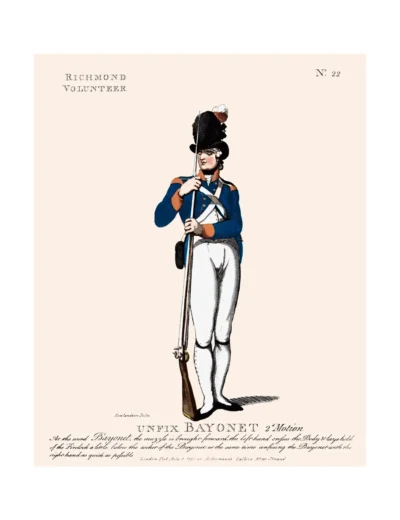No. 22 Richmond Volunteer
£12.50
Richmond (scroll down for a more detailed Description)
The first reprints of the 1798 aquatints by Thomas Rowlandson (published by Rudolph Ackermann) published in 1972 by Hugh Evelyn Limited.
Image size is 20.5 x 25.5 cm [8” x 10”] against a light greyish orange background (c. RGB fcf2e1) impressed on medium high white matt cartridge paper of c. 120 g/m2.
Print size: c. 26.2 x 33.7 cm [17” x 12 ¾”] may vary slightly from printers’ cut 50 years ago
Details of London Wards and Parishes provided by © the British Library
We offer thanks to the Trustees of the British Library and British Museum and Wikipedia for some text (and map outlines
Print is STANDARD size – shipping is the same for 1 to 10 prints (based on largest print size in your order) – see Shipping & Returns
Who were the Loyal Volunteers ? See here
In stock
Description

Richmond (see map) is a town in south-west London, 8.2 miles (13.2 km) west-southwest of Charing Cross. It is on a meander of the River Thames, with many parks and open spaces, including Richmond Park, and many protected conservation areas, which include much of Richmond Hill. A specific Act of Parliament protects the scenic view of the River Thames from Richmond. Richmond was founded following Henry VII‘s building of Richmond Palace in the 16th century, from which the town derives its name. (The palace itself was named after Henry’s earldom of Richmond, North Yorkshire, the original Richmond.) During this era, the town and palace were particularly associated with Elizabeth I, who spent her last days there. During the 18th century, Richmond Bridge was completed, and many Georgian terraces were built, particularly around Richmond Green and on Richmond Hill. Those that have survived remain well preserved and many have been designated listed buildings on account of their architectural or historic significance. The opening of Richmond railway station in 1846 was a significant event in the absorption of the town into a rapidly expanding London. Richmond was formerly part of the ancient parish of Kingston upon Thames in the county of Surrey. In 1890, the town became a municipal borough, which was later extended to include Kew, Ham, Petersham and part of Mortlake (North Sheen).The municipal borough was abolished in 1965, when, as a result of local government reorganisation, Richmond was transferred from Surrey to Greater London.
Richmond is now part of the London Borough of Richmond upon Thames and has a population of 21,469 (consisting of North Richmond and South Richmond wards). It has a significant commercial and retail centre with a developed day and evening economy. The name Richmond upon Thames is often used, incorrectly, to refer to the town of Richmond: in fact (unlike nearby Kingston upon Thames), the suffix should properly be used only in reference to the London Borough.
Additional information
| Weight | 0.0121 kg |
|---|---|
| Dimensions | 25 × 35 cm |





